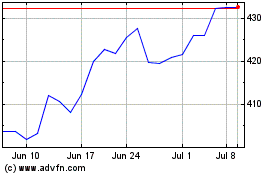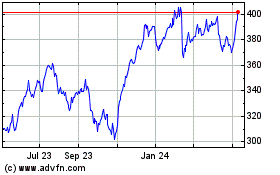Puerto Rico to Make Most Crucial of Debt Payments Due Jan. 1 -- Update
December 30 2015 - 5:13PM
Dow Jones News
By Aaron Kuriloff
Gov. Alejandro Garcia Padilla said Puerto Rico will make the
most crucial of its roughly $1 billion in bond payments due Jan. 1,
a strategy he said was aimed at staving off creditor lawsuits that
could exacerbate a financial crisis.
The U.S. commonwealth will pay about $330 million in general
obligation debt, which is guaranteed by the island's constitution,
after redirecting some money from bonds with weaker legal
protections, Mr. Padilla said in a conference call with
reporters.
The commonwealth's trustees will tap reserves to pay another
$383 million of the debt, including bonds from the highway and
convention center authorities. It will miss payment on about $37
million due on bonds from the Infrastructure Financing Authority
and the Public Finance Corp.
Those defaults are the latest from Puerto Rico, which owes
investors about $70 billion and has struggled with a decadelong
recession and a shrinking population that this year led Mr. Padilla
to declare its debts unpayable.
The government began missing bond payments in August and is
threatening to skip even more in the months ahead, possibly leading
to legal battles of increasing complexity as its coffers empty.
The payments are likely among the last Puerto Rico will make in
coming months, according to Mr. Padilla, who said on Wednesday that
the government's efforts would leave reserve accounts depleted.
The commonwealth will continue to pay bonds backed by sales
taxes, known by the Spanish acronym Cofina , but it doesn't have
access to that money to redirect it, Melba Acosta, president of the
island's Government Development Bank told reporters in the
conference call.
"What we've seen so far suggests a very strong desire to avoid
default on general obligation bonds and government-guaranteed
securities, and that's consistent with the knowledge that the
government will find itself in deep litigation as soon as it does,"
said Ted Hampton, an analyst at Moody's Investors Service, in an
interview last week.
Fear of expensive and expanding litigation has sent Puerto Rico
to the U.S. Congress asking for bankruptcy protection. The Obama
administration and congressional Democrats have called for Congress
to pass legislation that would allow the territory to restructure
its debt, but Republicans blocked an effort to grant such a
restructuring authority in the annual spending bill lawmakers
passed earlier this month.
Puerto Rico needs swift congressional action to create an
orderly restructuring process, a Treasury spokesman said on
Wednesday. "Puerto Rico is at a dead end, shifting funds from one
creditor to pay another and diverting money from already-depleted
pension funds to pay both current bills and debt service," he
said.
Efforts in Congress face opposition from some investors, who say
changing Puerto Rico's status isn't needed and sets a bad precedent
for states in financial distress. Several have argued for a
negotiated approach exemplified by talks involving the Puerto Rico
Electric Power Authority, which signed a deal with 70% of its
creditors that will see it make its scheduled payments.
The announced Jan. 1 defaults are "remarkably mild" given the
commonwealth's repeated warnings about its dwindling resources,
wrote Daniel Hanson, an analyst at the Washington-based investing
firm Height Securities, in a report on Wednesday. That could hurt
its credibility with the U.S. Congress, and because the island's
cash flows in 2015 have been higher than expected, "investors
should take the governor's claims about future bond payments with a
grain of salt," he said.
Joseph Rosenblum, director of municipal credit research at
AllianceBernstein, said the payment strategy only buys Puerto Rico
some time. "It does not say or do anything about their severe
liquidity crisis, their need to make future payments or the need to
continue to work on turning around their economy," he said.
Some Puerto Rico general obligation bonds maturing in 2035
traded at 73 cents on the dollar on Wednesday, up from about 71.75
cents on Tuesday.
Puerto Rico's economic problems have been compounded by
migration to the U.S. The Census Bureau reported last week that the
island's population fell by 1.7% in the year ended June. Its
population now stands nearly 10% below the level of July 2004.
Nick Timiraos and Lora Western contributed to this article.
Write to Aaron Kuriloff at aaron.kuriloff@wsj.com
(END) Dow Jones Newswires
December 30, 2015 16:58 ET (21:58 GMT)
Copyright (c) 2015 Dow Jones & Company, Inc.
Moodys (NYSE:MCO)
Historical Stock Chart
From Mar 2024 to Apr 2024

Moodys (NYSE:MCO)
Historical Stock Chart
From Apr 2023 to Apr 2024
